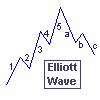| Elliott Waves a continuation of Waves? not exactly ... |
| >
Since we've been talking Waves, I guess we should also talk about Elliott Waves, >What do you know about Elliott Waves?
According to Elliott, event sequences occur in waves, from the very long (lasting hundreds of years, called Grand Super Cycle) to the very short (called sub-minuette, lasting maybe a few minutes) and, if you look carefully at the larger waves, you find smaller, or shorter, versions embedded within and ... >Smaller waves inside the bigger waves?
|  Ralph Nelson Elliott |

Well, this is what I did:
- I look at the S&P closing value in the month of January, 1930 and compare it to all monthly closing values from two years before (Jan, 1928) to two years after (Jan, 1932).
- I then move to Feb, 1930 and compare the closing value to the other values in a 4-year period centered on Feb/30.
- I then move to Mar, 1930 and compare the closing value to the other values in a 4-year period centered on Mar/30.
- I then move to Apr, 1930 and ...
I figure that, if there are Elliott Waves of the 5up/3dn variety, I should look at those months where the S&P close is the largest value in the 4-year time period.
>Okay! Okay! Did you find any?
I used a spreadsheet which looked something like
this (except that the one I used only had monthly gains, back
to 1928).
I found pretty pictures which look like ...

>Do you see 5up/3dn?
I'm still looking ...
>The spreadsheet ... can I play?
Okay, but remember that it's a draft and it looks for shorter-term waves (measured over about 70 days) and
it may or may not be useful and I can't guarantee that ...
>Yeah, okay. So?
... but there is a money-guarantee on its accuracy and ...
>Please!
Okay, then RIGHT-click here
and Save Target.


